
White-fronted capuchin
(Cebus albifrons)
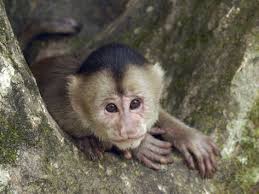
The white-fronted capuchin, is a species of capuchin monkey, a type of New World primate, found in seven different countries in South America: Bolivia, Brazil, Colombia, Venezuela, Ecuador, Peru, and Trinidad and Tobago. The species is divided into several different subspecies, though the specific divisions are uncertain and controversial.
This primate is a medium-sized monkey with a light brown back and a creamy white underside. Like other capuchin monkeys, it is omnivorous, feeding primarily on fruits, invertebrates, other plant parts and sometimes small vertebrates. It is predated upon primarily by raptors and probably small cats, especially the margay, though snakes have been known to attack the species. It is a polygamous animal and lives on fairly large groups of 15 to 35 individuals, reproductive females give birth to a single young at biennial intervals. The species maintains a home range of 1.2 to 1.5 km2 (0.46 to 0.58 sq mi) and has a complex vocal repertoire. It is one of the few primates to have been observed crafting and utilising tools in the wild.
White-fronted capuchin populations are declining. The decline is believed to be caused by human-induced habitat loss and degradation, and hunting. In 2008 the International Union for Conservation of Nature (IUCN) classified the Ecuadorian white-fronted capuchin (ssp. aequatorialis) and the Trinidad white-fronted capuchin (ssp. trinitatis) as critically endangered, and the varied white-fronted capuchin (ssp. versicolor) in Colombia is classified as endangered. The total population of the Trinidad subspecies was 61 at the last census.
Conservation status
Least concern
Scientific classification |
|
| Kingdom: | Animalia |
| Phylum: | Chordata |
| Class: | Mammalia |
| Order: | Primates |
| Family: | Cebidae |
| Genus: | Cebus |
| Specie: | Cebus albifrons |
Physical description

Male white-fronted capuchins usually weigh an average of 3.4 kg (7.5 lb) and the females an average of 2.9 kg (6.4 lb), although a male on Mirití-Paraná in Colombia weighed 5.5 kg (12 lb). This primate is usually maroon-white or palomino and creamy white. It has short fingers and an opposable thumb. Like other capuchin species its premolars are large, and it has square-shaped molar with a thick enamel to help with cracking nuts. Below are descriptions of the known subspecies for Colombia.
- Cebus albifrons albifrons is found in eastern Vichada, close to the type locality, and was defined by von Humboldt using a tame animal maintained by humans (and a pig) in the village of Maipures. The original description of von Humboldt described an ashy gray animal with a black tail tip, characteristics that are not typical of any known population of C. albifrons. The C. albifrons located three kilometers to the north of Maipures are very light colored animals with yellowish or reddish tones, very similar to the population of Arauca. Cebus a. unicolor is also very light colored with yellowish tones and it seems clear that it is a synonym of C. a. albifrons. One population of very pallid coloration is found in Arauca, the northern part of Boyacá and the eastern part of Norte de Santander and probably represents C. a. albifrons.
- Cebus a. cesarae is very light in color and quite well-defined as a subspecies. "The cap is cinnamon or snuff-brown; median dorsal region, forearm and forelag with orangeous and contrasted with sides of back and trunk; hairs of belly and chest ochracous-orange to pale ochraceous-buff and silvery; contrasting pale area of front extending over variable amounts of upper surface of shoulder and inner side of upper arm" (Hershkovitz, 1949).
- Cebus a. malitiosus is characterized by a color that is rather dark brown over almost the entire body with yellowish shoulders. "Pale area of front less extensive, upperparts and limbs paler than in hypoleucus. Cap prout's brown, median dorsal region cinnamon brown, forearm and foreleg not markedly contrasting in color with back and sides of body; hairs of belly and chest ochraceous-tawny to cinnamon-brown and silvery; contrasting pale area of front extending well over upper surface of shoulder and inner side of upper arm" (Hershkovitz, 1949).
- Cebus a. versicolor is a complex which includes dark populations and lighter populations. It is thought to include the subspecies C. a. leucocephalus and C. a. pleei. Herskovitz's description of C. a. pleei is of a very reddish animal, particularly in its limbs while C. a. versicolor is a lighter red. C. a. leucocephalus was described as a dark brown animal with reddish tonalities in the hind legs. Nevertheless, Hernández-Camacho and Cooper discuss evidence that the three subspecies (C. a. leucocephalus, C. a. pleei and C. a. versicolor) could be subsumed into one subspecies (C. a. versicolor), since the variations seem to be found in a very well-defined zone and even in the same groups, close to Barrancabermeja on the eastern bank of the middle Magdalena River in the Department of Santander. This strongly suggests that the dark phase (C. a. leucocephalus) and the light phase (C. a. pleei) are extremes of an intermediate (C. a. versicolor).
- Cebus a. cuscinus is subspecies found south of the Guamués River and colored a light brown.
Geographic range and habitat
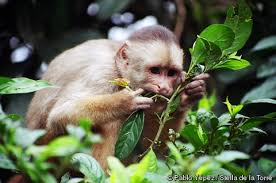
The white-fronted capuchin is found in a variety of forest types. In Vichada it exploits a more xeric habitat in terms of drainage, compared with the tufted capuchin, which tends to be found in forests that are more mesophytic. It is also found in flooded forests. The white-fronted capuchin survives well in forests growing over white sand and in forests of "high caatinga" growing in the rocks and gravel at the foot of mesas.
In Colombia, the white-fronted capuchin is found from the northern slopes of the Sierra de Santa Marta to the south, in the valley of the Magdalena River to an as yet undefined point in the Department of Tolima and in the valley of the lower Cauca River, to the eastern parts of central Antioquia and the southern parts of Sucre to the west. In Guajira the species is found to Riohacha, and an isolated population is apparently found in the Serranía de Macuira, though this needs confirmation. The species is also found along the slopes of the Serranía de Perijá and the Cordillera Oriental. To the east of the Cordillera the species is found in Norte de Santander, western Arauca, in eastern Vichada between the Meta and Tuparro rivers, and then south of the Vichada River; although east of the Ariari River, not including the Ariari itself. It is not known whether the species is found in the rather extensive forests of the upper Manacasías River in Meta. South of the Guayabero and Guaviare River, the white-fronted capuchin is found throughout the Amazon. The species is known to an altitude of 1,500–2,000 m (0.93-1.24 mi) in the Department of Tolima.
Outside of Colombia, the white-fronted capuchin is found from the Andes throughout eastern Ecuador, Peru and northern Bolivia to the Tapajós river in Brazil, south of the Amazon River. North of the Amazon River the species is found in the southern parts of the Venezuelan Federal State of Amazonas and in northern Brazil between Colombia and the Branco River. There are isolated populations of the Ecuadorian subspecies (ssp. aequatorialis) in the Pacific Equatorial Forest, with at least three troops present in the premontane cloud forest and moist transitional forest of the Jama-Coaque Reserve (Reserva Jama-Coaque) along the coastal equatorial mountain range in the province of Manabi, Ecuador.
Cebus albifrons albifrons is very common in the eastern half of El Tuparro National Park, Colombia. It is less common in Amacayacu National Park. Cebus a. yuracus is known south of the Putumayo River. Cebus a. versicolor is widespread on the middle-Magdalena River and is observable in preserved woodlots of protected fincas. Cebus a. malitiosus is easy to observe in Tayrona National Park, east of Santa Marta. Cebus a. cesarae can be located in the Serranía del Perijá east of Valledupar, Cesar also in Colombia.
Behavior
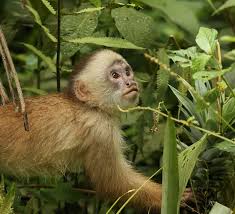
This species has been studied in Colombia by Defler, in two different sites in Peru by Soini and Terborgh, in Trinidad by Phillips and in Ecuador by Matthews.
In eastern Vichada, Colombia, the white-fronted capuchin is found in large groups of around 35 individuals, while to the south in closed forest (perhaps as a result of competition with the tufted capuchin) it has an average group size of 8-15 individuals. A group in Vichada used a home range of about 1.2 km2 (0.46 sq mi), while Terborgh found a home range of more than 1.50 km2 (0.58 sq mi) and Matthews calculated 240 hectares (590 acres). Near the type locality in gallery forest and islands of forest in Vichada, the species has an ecological density of around 30 individuals/km2. In forests with closed-canopy in Colombia and in southern Vichada, many areas have very low densities. Around the lower Apaporis River, for example, densities are less than one individual/km2 and the size of the groups is around 15 individuals. Low densities in many parts of the Colombian Amazon make it difficult to detect the presence of the species in many parts.
Terborgh found an average of 1,800 metres (1.1 mi) for the day range of a group, and calculated the following time budget of the study group in Manú National Park, Peru: 18% rest, 21% travel, 22% feeding on plant material and 39% feeding on insects; total feeding 61%. Matthews however, registered 54% foraging, 25% moving and 21% feeding and socializing. It is primarily quadrupedal, although it utilizes a great variety of gallops, jumps, falls and climbing. During certain times of the year the white-fronted capuchin is extremely terrestrial, especially when there is a scarcity of available fruits and the troop must search for arthropods in the dry leaves of the forest floor. In some parts of the Llanos Orientales it is found walking over the grassy savanna between forests, leaving well-beaten trails. In Vichada it uses preferential trees for sleeping at heights of 25-30 metres (82-98 ft). The palm Attalea regia is often used for sleeping in this zone.
Diet
All species of capuchin tend to have a rather similar diet in broad terms; they are omnivores, eating fruits and small invertebrates, small vertebrates and birds' eggs, which they forage at all levels of the forest, frequently descending to the forest floor. In northern Colombia during the dry season when there are few fruits to be found, the white-fronted capuchin spends more than half its time on the ground, searching for and capturing small prey. It is extremely good at manipulating objects, and spends a great deal of time examining dry leaves from which it collects invertebrates (for example small beetles and ants' eggs) from rolled up leaves. It hunts frogs and drinks the water which accumulates in the spaces between the bracteoles of the common plant Phenakospermum guianense, where the frogs hide. Hunting amphibians seems to be a cultural phenomenon which the members of each group learn. P. guianense is commonly present in large, dense stands in some types of forest.In Manú National Park the animal material in the diet includes frogs, lizards, small mammals and birds' eggs as well as many invertebrates, including orthopterans, lepidopterans and hymenopterans (especially ants and wasp larvae). In the Pacaya-Samiria National Reservation, it has been observed eating tent caterpillars. Terborgh identified 73 species of plants from 33 families consumed by this primate. The Moraceae was the most important family by a wide margin, counting the number of species (17) eaten, equivalent to 23.3% of all plant species consumed. Importance values for plant families consumed by the white-fronted capuchin in one study are as follows: Moraceae (17, 23.3%); Leguminosae (5, 6.8%); Araceae (4, 5.5%); Bombacaceae (4, 5.5%); Palmae (4, 5.5%).
Defler collected 40 species of plants from 23 families eaten by this primate in Vichada according to species consumed per family: Arecaceae (7); Moraceae (6); Chrysobalanaceae (3); Leguminosae (3); Passifloraceae (2); Bromeliaceae (2); Burseraceae (2); Bombacaceae (1); Celastraceae (1); Connaraceae (1); Euphorbiaceae (1); Lecythidaceae (1); Maranthaceae (1); Melastomataceae (1); Anacardiaceae (1); Myrtaceae (1); Annonaceae (1); Musaceae (1); Apocynaceae (1); Orchidaceae (1); Araceae (1); Rubiaceae (1); Bignoriaceae (1).
In terms of importance value, palms are highly valued by all species of capuchin. In El Tuparro National Park in Colombia, the palm Attalea regiae was a key species for this primate, the nuts being a principal food. In Manú National Park in Peru the palms Astrocaryum and Attalea were the most important palm genera, but perhaps not at the same level as Attalea in El Tuparro. Also, at Manú various species of Ficus were very important to the white-fronted capuchin; this emphasis on Ficus was not observed in the El Tuparro study, although this study did not include an entire year. Nevertheless, research on other species suggests the importance of palms as "key species" and the lack of importance of Ficus in such habitats as gallery forests in the llanos of Colombia and Venezuela, contrasts with their high importance in more fertile habitats like Manú.
The white-fronted capuchin takes advantage of almost any water source, drinking water from tree holes when available, but also drinking from brooks and springs when necessary. During the driest season in Vichada the group studied by Defler went to the ground every day to a water seep from under a huge boulder, which was the only water source available in their home range.
Reproduction
This species of capuchin is polygamous. The male mounts the female, holding her legs with his hind feet, and copulates with her for a few minutes. Although the time of gestation is unknown, it is probably around 160 days like the tufted capuchin. Usually one infant is born. Observations of a newborn in El Tuparro National Park showed the process by which the newborn discovered the appropriate position for riding on the mother. Newborns ride oriented sideways over the mothers' shoulders, but during the first days the baby holds on to any part of the mother such as the base of the tail, the tail, the legs, and the arms before discovering and learning that the position over the shoulders is best and most secure. After several weeks the baby makes the change from the sideways position over the shoulders to riding on her back.All the members of the troop are interested in the newborn, and they take advantage of any opportunity to examine and look at its genitals if the mother permits it. With time the baby begins to climb up on other members of the troop, including the adult males who are interested in protecting the little one. Playing behavior is principally with a companion, and all members of the troop from the alpha male, the mother and all young members of the group solicit play with the young one.
Social structure
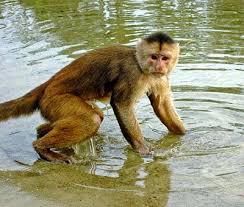
El Tuparro, which resulted in one group fleeing towards the central parts of their territory. Alpha males seem to exercise a "control position" at the center of the group, since all members are extremely conscious and alert to his location, and they all observe his reactions. If the alpha reacts with intense fear or panic or if he pays close attention to something, all members of the troop react similarly. The presence of adult males seems to lend psychological support to the smaller adult females. Defler noticed that more timid females often became quite aggressive towards him when a male appeared on the scene, although the females often needed to press up against the flank of the male for reassurance.
Communication
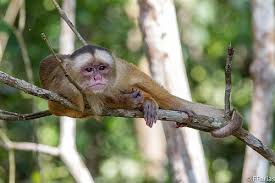
Vocalizations are variable, and some are listed as follows: (1) ua - a soft bark given repeatedly and used by all members of the group when danger is perceived; (2) ya - excited animals around the alpha, towards alpha and towards perceived danger; (3) eh-eh - threat towards potential danger, but especially adult females; accompanied with open mouth showing teeth (OMT); (4) squeaky hinge - threat given especially by young animals; (5) squeal - conflict within the group during a fight; (6) whistle - conflict in the group of a young animal; (7) ahr - a lost animal; others answer this call, apparently to direct it back to the group; (8) uh!uh!uh! - a common vocalization during feeding which may allow contact to be maintained and show general contentment; (9) uch!uch! - an animal trying to keep up with the group; (10) warble - young animals establishing contact or coming close to an adult; (11) purr - close and pacific contact; (12) chirriar - pacific interaction of young ones during play.
Perhaps the most important display is the behavior of breaking branches, which all members of the group carry out. Even infants break small branches (or twigs), letting them fall to the soil, but the most spectacular is the alpha male who chooses large, dry branches which he hits with his hands and feet in spectacular jumps, so that they fall. Usually such branches make a tremendous sound as they fall through the other branches, and the members of the group become very excited and chatter loudly. This behavior is quite commonly discharged towards an observer when the animals have lost their fear.
Zoológico de Vallarta A. C.
Leave your comments, your opinion is important to us

